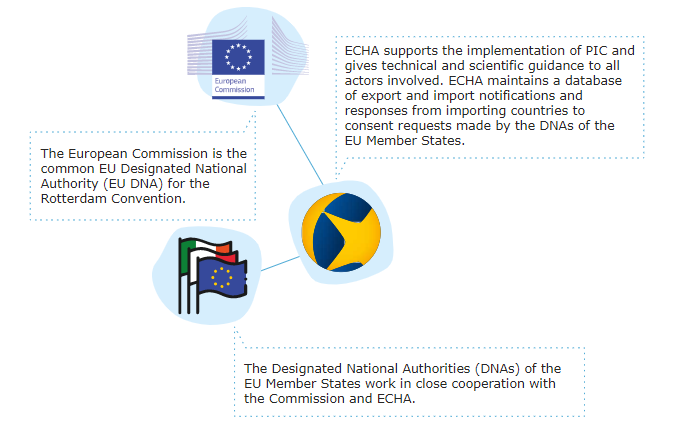On August 25, 2023, the European Commission published the Commission Delegated Regulation (EU) 2023/1656 amending Regulation (EU) No 649/2012.
35 chemicals – 27 pesticides and 8 industrial chemicals – were added. Currently, there are 295 entries in the Annex I.
The amendments will come into force from November 1, 2023.
The following entries are added:
Serial No. | Chemicals | CAS No. | EC No. | CN Code |
| 1 | ‘1-bromopropane (n-propyl bromide) | 106-94-5 | 203-445-0 | ex 2903 69 19 |
| 2 | 1,2-Benzenedicarboxylic acid, di-C6-8-branched alkyl esters, C7-rich | 71888-89-6 | 276-158-1 | ex 2917 34 00 |
| 3 | 1,2-Benzenedicarboxylic acid, di-C7-11-branched and linear alkyl esters | 68515-42-4 | 271-084-6 | ex 2917 34 00 |
| 4 | 1,2-Benzenedicarboxylic acid, dipentyl ester, branched and linear | 84777-06-0 | 284-032-2 | ex 2917 34 00 |
| 5 | Alpha-cypermethrin | 67375-30-8 |
| ex 2926 90 70 |
| 6 | Azimsulfuron | 120162-55-2 |
| ex 2935 90 90 |
| 7 | Bis(2-methoxyethyl) phthalate | 117-82-8 | 204-212-6 | ex 2917 34 00 |
| 8 | Bromadiolone | 28772-56-7 | 249-205-9 | ex 2932 20 90 |
| 9 | Carbetamide | 16118-49-3 | 240-286-6 | ex 2924 29 70 |
| 10 | Carboxin | 5234-68-4 | 226-031-1 | ex 2934 99 90 |
| 11 | Chlorophene | 120-32-1 | 204-385-8 | ex 2908 19 00 |
| 12 | Cyproconazole | 94361-06-5 |
| ex 2933 99 80 |
| 13 | Diisopentyl phthalate | 605-50-5 | 210-088-4 | ex 2917 34 00 |
| 14 | Dipentyl phthalate | 131-18-0 | 205-017-9 | ex 2917 34 00 |
| 15 | Diuron | 330-54-1 | 206-354-4 | ex 2924 21 00 |
| 16 | Esbiothrin | 260359-57-7 |
| ex 2916 20 00 |
| 17 | Ethametsulfuron-methyl | 97780-06-8 |
| ex 2935 90 90 |
| 18 | Etridiazole | 2593-15-9 | 219-991-8 | ex 2934 99 90 |
| 19 | Famoxadone | 131807-57-3 |
| ex 2934 99 90 |
| 20 | Fenbuconazole | 114369-43-6 | 406-140-2 | ex 2933 99 80 |
| 21 | Fenoxycarb | 72490-01-8 | 276-696-7 | ex 2924 29 70 |
| 22 | Fluquinconazole | 136426-54-5 | 411-960-9 | ex 2933 59 95 |
| 23 | Indoxacarb | 173584-44-6 144171-61-9 |
| ex 2934 99 90 |
| 24 | Isopyrazam | 881685-58-1 |
| ex 2933 19 90 |
| 25 | Lufenuron | 103055-07-8 | 410-690-9 | ex 2924 21 00 |
| 26 | Metam-sodium | 137-42-8 | 205-293-0 | ex 2930 20 00 |
| 27 | Metosulam | 139528-85-1 | 410-240-1 | ex 2935 90 30 |
| 28 | Myclobutanil | 88671-89-0 | 410-400-0 | ex 2933 99 80 |
| 29 | n-pentyl-isopentyl phthalate | 776297-69-9 |
| ex 2917 34 00 |
| 30 | Pencycuron | 66063-05-6 | 266-096-3 | ex 2924 21 00 |
| 31 | Phosmet | 732-11-6 | 211-987-4 | ex 2930 90 98 |
| 32 | Prochloraz | 67747-09-5 | 266-994-5 | ex 2933 29 90 |
| 33 | Profoxydim | 139001-49-3 |
| ex 2934 99 90 |
| 34 | Spirodiclofen | 148477-71-8 |
| ex 2932 20 90 |
| 35 | Triflumizole | 68694-11-1 |
| ex 2933 29 90 |
Understanding PIC
The Prior Informed Consent (PIC) Regulation governs the trade of certain hazardous chemicals that are banned or severely restricted in the EU. It places obligations on companies that wish to export these chemicals to non-EU countries or import them into the EU. PIC implements the Rotterdam Convention within the EU. It promotes shared responsibility and cooperation in the international trade of hazardous chemicals. It also protects human health and the environment by providing importing countries with information on how to store, transport, use, and dispose of hazardous chemicals safely. The PIC Regulation has been in force since March 1, 2014.
Annex I of the PIC Regulation listed chemicals that are banned or severely restricted, including:
- Active substances in pesticides or in biocidal products such as disinfectants, insecticides or parasiticides;
- Industrial chemicals; and
- Chemicals that are banned for export from the EU and listed in Annex V to the PIC Regulation
Notifying exports and receiving export permission
Companies intending to export chemicals listed in PIC to non-EU countries, need to notify their intention to export and get permission for export before exporting.
Obligation of reporting
Each year, importers and exporters of PIC chemicals need to send information on the exact quantities of the chemical shipped to or from each non-EU country in the preceding year to the designated national authorities.
PIC actors in the EU

If you need any assistance or have any questions, please get in touch with us via service@cirs-group.com.
Reference
https://echa.europa.eu/-/35-hazardous-chemicals-added-to-the-prior-informed-consent-regulation

